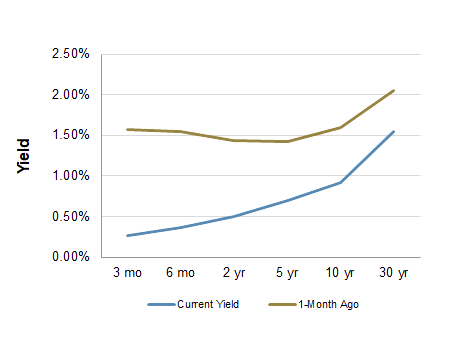Weekly Market Snapshot
Chief Economist Scott Brown discusses the latest market data.
The lack of sufficient testing makes it difficult to access the spread of COVID-19. The increase in social distancing (avoiding crowds, reduced tourism and travel, canceled spectator events) should slow the spread and prevent hospitals from being overrun with infected cases. However, social distancing will also result in a more significant impact on the economy, likely pushing the U.S. into a recession in the near term. Last week, we saw liquidity issues in the credit markets. That this arrives ahead of much of the economic impact is worrisome. The Federal Reserve reacted quickly, announcing $1.5 trillion in support for the money markets and a significant increase in asset purchases.
Lower interest rates, lower gasoline prices and expected fiscal stimulus should help to limit (but not prevent) the downside to the economy and should help propel the rebound once the coronavirus passes. However, the downturn may be severe and longer-lasting, and there could be more permanent adjustments to consumer behavior. We don’t know for sure since we don’t know much about how far the virus will spread and how consumers will respond. This radical uncertainty has had a major impact on the financial markets and we can expect volatile conditions as investors try to better assess the situation over time.
Next week, the Federal Open Market Committee is expected to lower short-term interest rates further, most likely by 100 basis points, dropping the target range for the federal funds rate to 0-0.25%. Senior Fed officials will also put forth revised projections of GDP growth (4Q/4Q), unemployment and inflation. We’ll get a new dot plot. Chair Powell will be there to explain it all. Regarding the economic data, February is not a big month for retailers and it’s too soon to see much of an impact on sales from COVID-19.
Indices
| Last | Last Week | YTD return % | |
|---|---|---|---|
| DJIA | 21200.62 | 26121.28 | -25.71% |
| NASDAQ | 7201.80 | 8738.60 | -19.74% |
| S&P 500 | 2480.64 | 3023.94 | -23.22% |
| MSCI EAFE | 1491.75 | 1856.73 | -26.77% |
| Russell 2000 | 1122.93 | 1478.82 | -32.70% |
Consumer Money Rates
| Last | 1 year ago | |
|---|---|---|
| Prime Rate | 4.25 | 5.50 |
| Fed Funds | 1.25 | 2.40 |
| 30-year mortgage | 3.63 | 4.40 |
Currencies
| Last | 1 year ago | |
|---|---|---|
| Dollars per British Pound | 1.257 | 1.334 |
| Dollars per Euro | 1.119 | 1.133 |
| Japanese Yen per Dollar | 104.64 | 111.17 |
| Canadian Dollars per Dollar | 1.393 | 1.330 |
| Mexican Peso per Dollar | 21.940 | 19.285 |
Commodities
| Last | 1 year ago | |
|---|---|---|
| Crude Oil | 31.50 | 58.26 |
| Gold | 1590.30 | 1309.30 |
Bond Rates
| Last | 1 month ago | |
|---|---|---|
| 2-year treasury | 0.50 | 1.43 |
| 10-year treasury | 0.92 | 1.60 |
| 10-year municipal (TEY) | 2.57 | 1.88 |
Treasury Yield Curve – 03/13/2020

As of close of business 03/12/2020
S&P Sector Performance (YTD) – 03/13/2020

As of close of business 03/12/2020
Economic Calendar
| March 17 | — | Retail Sales (February) |
| — | Industrial Production (February) | |
| — | Homebuilder Sentiment (March) | |
| March 18 | — | Building Permits, Housing Starts (February) |
| — | FOMC Policy Decision | |
| — | Fed Summary of Economic Projections | |
| March 25 | — | Durable Goods Orders (February) |
| March 31 | — | CB Consumer Confidence (March) |
| April 1 | — | ISM Manufacturing Index (March) |
| April 3 | — | Employment Report (March) |
| April 10 | — | Good Friday Holiday (markets closed) |
| April 29 | — | FOMC Policy Decision |
All expressions of opinion reflect the judgment of the Research Department of Raymond James & Associates, Inc. and are subject to change. There is no assurance any of the forecasts mentioned will occur or that any trends mentioned will continue in the future. Investing involves risks including the possible loss of capital. Past performance is not a guarantee of future results. International investing is subject to additional risks such as currency fluctuations, different financial accounting standards by country, and possible political and economic risks, which may be greater in emerging markets. While interest on municipal bonds is generally exempt from federal income tax, it may be subject to the federal alternative minimum tax, and state or local taxes. In addition, certain municipal bonds (such as Build America Bonds) are issued without a federal tax exemption, which subjects the related interest income to federal income tax. Municipal bonds may be subject to capital gains taxes if sold or redeemed at a profit. Taxable Equivalent Yield (TEY) assumes a 35% tax rate.
The Dow Jones Industrial Average is an unmanaged index of 30 widely held stocks. The NASDAQ Composite Index is an unmanaged index of all common stocks listed on the NASDAQ National Stock Market. The S&P 500 is an unmanaged index of 500 widely held stocks. The MSCI EAFE (Europe, Australia, Far East) index is an unmanaged index that is generally considered representative of the international stock market. The Russell 2000 index is an unmanaged index of small cap securities which generally involve greater risks. An investment cannot be made directly in these indexes. The performance noted does not include fees or charges, which would reduce an investor’s returns. U.S. government bonds and treasury bills are guaranteed by the US government and, if held to maturity, offer a fixed rate of return and guaranteed principal value. U.S. government bonds are issued and guaranteed as to the timely payment of principal and interest by the federal government. Treasury bills are certificates reflecting short-term (less than one year) obligations of the U.S. government.
Commodities trading is generally considered speculative because of the significant potential for investment loss. Markets for commodities are likely to be volatile and there may be sharp price fluctuations even during periods when prices overall are rising. Specific sector investing can be subject to different and greater risks than more diversified investments. Gross Domestic Product (GDP) is the annual total market value of all final goods and services produced domestically by the U.S. The federal funds rate (“Fed Funds”) is the interest rate at which banks and credit unions lend reserve balances to other depository institutions overnight. The prime rate is the underlying index for most credit cards, home equity loans and lines of credit, auto loans, and personal loans. Material prepared by Raymond James for use by financial advisors. Data source: Bloomberg, as of close of business March 12, 2020.

